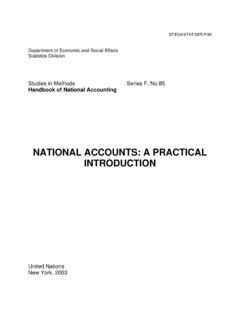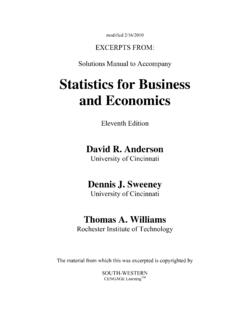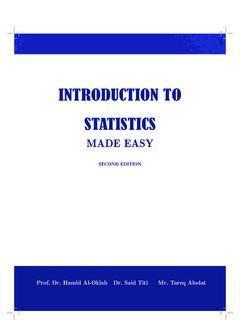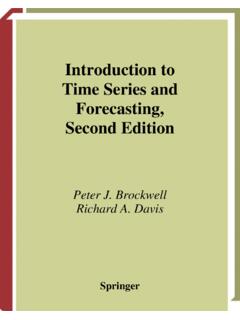Transcription of Business Mathematics and Statistics, Sixth Edition
1 Licensed to: Business Mathematics and StatisticsAndre Francis BSc MScPerinatal InstituteBirminghamAndre Francis works as a medical statistician. He has previously taught Mathematics , statistics and Information Processing to students on busi -ness and professional courses. His teaching experi-ence has covered a wide area, including training students learning basic skills through to teaching undergraduates. He has also had previous indus-trial (costing) and commercial (export) experience and served for six years in statistical branches of Training Command in the Royal Air Force. Sixth EditionAustralia Canada Mexico Singapore Spain United Kingdom United StatesCopyright 2004 Cengage Learning, Inc. All Rights Reserved. May not be copied, scanned, or duplicated, in whole or in to:AcknowledgementsThe author would like to express thanks to the many students and teachers who have contributed to the text in various ways over the years.
2 In particular he would like to thank the following examining bodies for giving permis-sion to reproduce selected past examination questions: Chartered Association of Certified Accountants (ACCA) Chartered Institute of Management Accountants (CIMA) Institute of Chartered Secretaries and Administrators (ICSA) Chartered Institute of Insurance (CII) Association of Accounting Technicians (AAT)Each question used is cross referenced to the appropriate Institute or CIP catalogue record for this book is available from the British LibraryFirst Edition 1986 Second Edition 1988; Reprinted 1990; Reprinted 1991 Third Edition 1993; Reprinted 1993 Fourth Edition 1995; Reprinted 1996; Reprinted 1997 Fifth Edition 1998; Reprinted 2003 by Thomson LearningSixth Edition 2004; Published by Thomson LearningCopyright A.
3 Francis 2004 ISBN 1-84480-128-4 All rights reservedNo part of this publication may be reproduced, stored in a retrieval system, or transmitted in any form or by any means, electronic, mechanical, photocopying, recording or otherwise, without the prior permission of the copyright owner except in accordance with the provisions of the Copyright, Designs and Patents Act 1988 or under the terms of a licence issued by The Copyright Licensing Agency Ltd, 90 Tottenham Court Road, London W1P 9HE. Applications for the copyright owner s permission to reproduce any part of this publication should be addressed to the in Nottingham, UK by Andre FrancisPrinted in Croatia by Zrinski 2004 Cengage Learning, Inc. All Rights Reserved. May not be copied, scanned, or duplicated, in whole or in 1 Introduction to Business Mathematics and 1 Data and their 2 Sampling and Data 3 Data and their 4 Frequency Distributions and 5 General Charts and Examination 2 Statistical 6 Arithmetic 7 8 Mode and Other Measures of 9 Measures of Dispersion and 10 Standard 11 Quantiles and the Quartile Examination example and 3 Regression and 12 Linear Functions and 13 Regression 14 Correlation Examination examples and 4 Time series 15 Time Series 16 Time Series 17 Seasonal Variation and Examination example and 5 Index 18 Index 19 Composite Index 20 Special Published Examination 6 Compounding.
4 Discounting and 21 Interest and 22 Present Value and Investment 23 Examination examples and 2004 Cengage Learning, Inc. All Rights Reserved. May not be copied, scanned, or duplicated, in whole or in to:ivPart 7 Business equations and graphs 337 24 Functions and Graphs 338 25 Linear Equations 351 26 Quadratic and Cubic Equations 364 27 Differentiation and Integration 374 28 Cost, Revenue and Profit Functions 385 Examination examples and questions 395 Part 8 Probability 403 29 Set Theory and Enumeration 404 30 Introduction to Probability 419 31 Conditional Probability and Expectation 436 Examination examples and questions 449 Part 9 Further probability 455 32 Combinations and Permutations 456 33 Binomial and Poisson Distributions 462 34 Normal Distribution 473 Examination example and questions 490 Part 10 Specialised Business applications 495 35 Linear Inequalities 496 36 Matrices 508 37 Inventory Control 526 38 Network Planning and Analysis 543 Examination example and questions 555 Answers to student exercises 562 Answers to examination questions 581 Appendices 650 1 Compounding and Discounting Tables 650 2 Random
5 Sampling Numbers 654 3 Exponential Tables. Values of e m 655 4 Standard Normal Distribution Tables 657 Index 659 ContentsCopyright 2004 Cengage Learning, Inc. All Rights Reserved. May not be copied, scanned, or duplicated, in whole or in to:vPreface1. Aims of the bookThe general aim of the book is to give a thorough grounding in basic Mathematical and Statistical techniques to students of Business and Professional studies. No prior knowledge of the subject area is Courses covereda) The book is intended to support the courses of the following professional bodies: Chartered Association of Certified Accountants Chartered Institute of Management Accountants Institute of Chartered Secretaries and Administratorsb) The courses of the following bodies which will be supported by the book to a large extent: Chartered Institute of Insurance Business and Technical Education Council (National level) Association of Accounting Techniciansc) The book is also meant to cater for the students of any other courses who require a practical foundation of Mathematical and Statistical techniques used in Business , Commerce and Format of the bookThe book has been written in a standardised format as follows.
6 A) There are TEN separate parts which contain standard examination testing ) Numbered chapters split up the parts into smaller, identifiable segments, each of which have their own Summaries and Points to ) Numbered sections split the chapters up into smaller logical elements involving descriptions, definitions, formulae or the end of each chapter, there is a Student Self Review section which contains questions that are meant to test general concepts, and a Student Exercise section which concentrates on the more practical numerical aspects covered in the the end of each part, there is a) a separate section containing examination examples with worked solutions and b) examination questions from various bodies. Worked solutions to these ques-tions are given at the end of the 2004 Cengage Learning, Inc.
7 All Rights Reserved. May not be copied, scanned, or duplicated, in whole or in to:vi4. How to use the bookChapters in the book should be studied in the order that they studying each section in a chapter, the Summaries and Points to Note should be checked through. The Student Self Review Questions, which are cross-refer-enced to appropriate sections, should first be attempted unaided, before checking the answers with the text. Finally the Student Exercises should be worked through and the answers obtained checked with those given at the end of the completing a particular part of the book, the relevant section of the examina-tion questions (at the end of the book) should be attempted. These questions should be considered as an integral part of the book, all the subject matter included having been covered in previous chapters and parts.
8 Always make some attempt at the questions before reading the The use of calculatorsExamining bodies permit electronic calculators to be used in examinations. It is therefore essential that students equip themselves with a calculator from the begin-ning of the facilities that the calculator should include are:a) a square root function, andb) an accumulating desirable extra facilities are:c) a power function (labelled xy ),d) a logarithm function (labelled log x ), ande) an exponential function (labelled ex ).Some examining bodies exclude the use (during examinations) of programmable calculators and/or calculators that provide specific statistical functions such as the mean or the standard deviation. Students are thus urged to check on this point before they purchase a calculator. Where relevant, this book includes sections which describe techniques for using calculators to their best Francis, 2004 PrefaceCopyright 2004 Cengage Learning, Inc.
9 All Rights Reserved. May not be copied, scanned, or duplicated, in whole or in to:Answers to examination questionsPart 1 Question 1 Simple random sampling. A method of sampling whereby each member of the popu-lation has an equal chance of being chosen. Normally, random sampling numbers are used to select individual items from some defined sampling frame. Stratification. This is a process which splits a population up into as many groups and sub-groups (strata) as are of significance to the investigation. It can be used as a basis for quota sampling, but more often is associated with stratified (random) sampling. Stratified sampling involves splitting the total sample up into the same proportions and groups as that for the population stratification and then sepa-rately taking a simple random sample from each group.
10 For example, employees of a company could be split into male/female, full-time/part-time and occupation category. Quota sampling. A method of non-random sampling which is popular in market research. It uses street interviewers, armed with quotas of people to interview in a range of groups, to collect information from passers-by. For example, obtaining peoples attitudes regarding the worth of secondary double glazing. Sample frame. This is a listing of the members of some target population which needs to be used in order to select a random sample. An example of a sampling frame would be a stock list, if a random sample was required from current ware-house stock. Cluster sampling. This is another non-random method of sampling, used where no sampling frame is in evidence. It consists of selecting (randomly) one or more areas, within which all relevant items or subjects are investigated.





